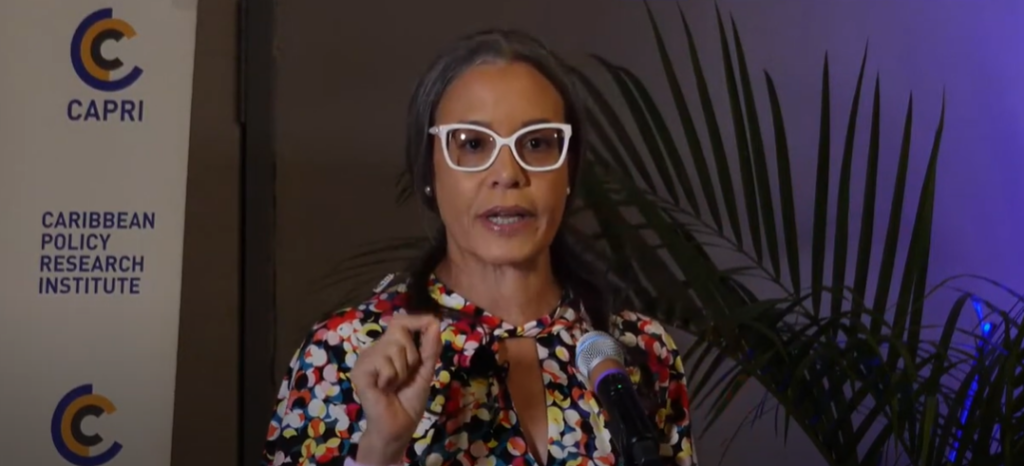

Diana Thorburn, director of research at the Caribbean Policy Research Institute (CAPRI), underscored that women’s roles in organised crime are less visible than men’s during her address at a CAPRI official report launch and discussion on Tuesday under the theme ‘Hits and Misses: Women in Organise Violence.’
Thorburn stated that there is a popular idea of rising female gangsters in Jamaica, which requires deep understanding to identify how this issue threatens Jamaica’s peace, citizens’ security, and overall well-being as a country.
She emphasised that statistically, data indicates that women are less involved in violent crimes. “Women are more commonly involved in non-violent offences such as drug trafficking and financial crimes. Women commit far fewer violent crimes than men do, women rarely directly commit violent crimes and when they do it’s almost always in domestic settings or personal disputes not in gang-related shootings,” she said.
“The most prevalent form of domestic violence committed by women in Jamaica is violence against children,” Thorburn added.
She also highlighted that women’s involvement in violent crimes is relatively low. “Women’s involvement in serious violent crimes is marginal as less than 3 per cent were arrested and charged for category one crimes such as murders, shooting, assault, larceny and robbery. In 2021, for just murder alone, women accounted for just 2 per cent of all arrests. Women also made up some four per cent of gang-related arrests in 2024,” she continued.

Thorburn further noted that another confounding factor is that international trends do not match Jamaica’s confounding reality. “Across the world, there is an increase of women involved in violent crimes. They are participating at a higher rate; they’re being incarcerated at a higher rate than men are for violent crime, including the Latin American region. But in the Caribbean, female incarceration rates are holding steady and are actually declining, and Jamaica has one of the lowest incarceration rates in the entire hemisphere; only lower than us are Haiti and Guatemala,” Thorburn said.
Rising female criminality is not borne out by statistical data
However, Thorburn stated that it is also possible that women’s involvement in violent crimes isn’t fully captured in statistical data.
“Across criminology, the female invisibility phenomenon is well documented; women’s roles in crime are often less visible, underreported, or harder to detect. Further, while the numbers may not show a significant rise in female participation in gang violence, there are structural and contextual factors and shifts that do support the notion,” she stated.
She exclaimed that though Jamaica has a low incarceration rate, which makes it difficult to identify female involvement in crime, there are other factors that point to females taking up space in violent activities.
“Firstly, of these is generally Jamaica’s low incarceration rate, meaning that there is a negative correlation between the number of homicides and the number of people imprisoned in Jamaica. So many criminals, male and female, are not in prison. Therefore, incarceration data is not helpful to tell whether women are increasing more in violent crimes.”
She continued: “Secondly, the dynamics of Jamaica’s contemporary labour market, we have a record low unemployment rate and one of the region’s highest labour force participation rates. Within this context here in Jamaica, women’s labour force participation rate is rising faster than men’s, so it stands to reason that more women might also be entering the criminal workforce. The third factor is the post-2014 shift in organised crime in Jamaica—moving the violent crime landscape from rigid hierarchies and large gangs to smaller, more fluid networks, creating new opportunities for women.”
Thorburn expressed that it’s possible that traditional crime data is missing aspects of women’s involvement in organised violent groups.
Thorburn added: “Even if official crime statistics do not capture women’s participation in organised crime, we do have other sources of evidence that help us understand their involvement. These include media reports, statements from police, security personnel, and stakeholders; academic and policy literature from other Caribbean countries; arrest records under the anti-gang legislature; gang trial proceedings; and social media and popular culture.
“So women in gangs play key but not directly violent roles. They are not pulling the trigger. …So while they participate in gangs, they are not the ones typically doing the killings,” she added.






Comments